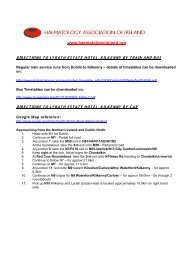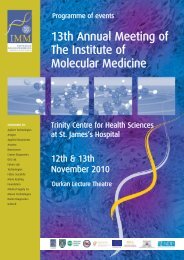Guidelines on Diagnosis and Treatment of Malignant Lymphomas
Guidelines on Diagnosis and Treatment of Malignant Lymphomas
Guidelines on Diagnosis and Treatment of Malignant Lymphomas
Create successful ePaper yourself
Turn your PDF publications into a flip-book with our unique Google optimized e-Paper software.
Potential diagnostic pitfalls for<br />
large/intermediate cell morphology<br />
N<strong>on</strong>-lymphoid malignancy<br />
■ Germ Cell tumour<br />
■ Carcinoma<br />
■ Melanoma<br />
■ Sarcoma<br />
Burkitt lymphoma is missed – (If proliferative index<br />
(Ki67) is high <strong>and</strong> BCL2 is negative – think Burkitt)<br />
C<strong>on</strong>firm with Molecular genetic studies for MYC <strong>and</strong><br />
BCL2 translocati<strong>on</strong>s<br />
B Cell Lymphoblastic lesi<strong>on</strong>s - (include TdT in panel)<br />
Myeloid lesi<strong>on</strong>s If CD20 is negative but CD79A positive<br />
Plasma Cell lesi<strong>on</strong>s c<strong>on</strong>sider these<br />
“Blastic” Mantle Cell lymphoma – include CD5 in<br />
initial panel. C<strong>on</strong>firm with Cyclin D1 or molecular genetic<br />
studies for BCL1 translocati<strong>on</strong>.<br />
10
















